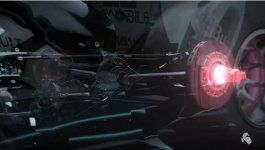MitchJi
10 MW
Hi,
Complete article here:
http://www.greencarcongress.com/2010/11/hondas-f1-kers-motor-60-kw-21000-rpm-7-kg.html#more
Excerpts:
Complete article here:
http://www.greencarcongress.com/2010/11/hondas-f1-kers-motor-60-kw-21000-rpm-7-kg.html#more
Excerpts:
Honda’s F1 KERS motor: 60 kW, 21,000 RPM, >7 kg
25 November 2010
During the EVS 25 electric vehicle expo in Shanghai earlier this months, Honda engineers presented a glimpse into the development of an advanced high-performance electric motor that Honda had designed as part of a KERS (Kinetic Energy Recovery System) intended for its 2009 Formula One race car...
Stator Core. A three-phase, four-pole, twelve-tooth design with a double lap-wound stator and permanent magnet rotor was selected. Operating motor speed would be roughly equivalent to engine speed, with a range of 13,000 to 21,000 rpm (engine speed was limited to 18,000 rpm during the 2009 F1 season).
An initial concern, particularly given the high motor speed, was the effect of iron losses in the stator core, which is typically an AC motor’s heaviest component. Conventional grain-oriented silicon steel was not efficient enough to be used in a motor that would meet the project’s motor size and weight targets, and an iron-cobalt alloy (49Fe-49Co-2V) was used to produce the motor’s stator core laminations. This yielded a 30% increase in flux density and a 15% increase in torque.
The iron-cobalt alloy’s iron losses were further reduced via a combination of technologies. A post-rolling heat treatment reduced core hysteresis losses, and an ultra-thin oxidized insulation coating was developed, which allowed the engineers to reduce stator core lamination thickness to a tenth of a millimeter per lamination while preserving the desired iron-to-insulation ratio. These refinements reduced the alloy’s iron losses by a further 60%...
Rotor Design. Honda developed a high-coercivity magnet with an intrinsic coercivity of at least 1.1 Ma/m at 160ºC (320ºF), and tuned the magnetization angles for maximum torque. To minimize temperature increases and resultant eddy current losses, 448 magnets (28 axially, 16 circumferentially) were used in the rotor’s interior PM configuration.
Rotor diameter was reduced by employing the rotor’s shaft as part of the rotor flux circuits. A high tensile filament winding made of organic high-strength fibers encloses the rotor, preventing magnet burst at the centrifugal forces produced at the rotor’s 21,000 rpm redline. The rotor’s ceramic ball bearings were lubricated by high-temperature grease rather than oil, to simplify the oil circuit and reduce losses...
Implementation and testing.
...The final design achieved 7.8 kW (10.46 hp) of power per kilogram, close to Honda's design goal of 8 kilowatts per kilogram. Peak motor efficiency was 99% and peak generator efficiency during regen was 93%. Motor weight was 6.9 kilograms...


